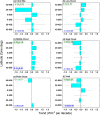Observational Assessment of Changes in Earth's Energy Imbalance Since 2000
- PMID: 39734427
- PMCID: PMC11671437
- DOI: 10.1007/s10712-024-09838-8
Observational Assessment of Changes in Earth's Energy Imbalance Since 2000
Abstract
Satellite observations from the Clouds and the Earth's Radiant Energy System show that Earth's energy imbalance has doubled from 0.5 ± 0.2 Wm-2 during the first 10 years of this century to 1.0 ± 0.2 Wm- 2 during the past decade. The increase is the result of a 0.9 ± 0.3 Wm-2 increase absorbed solar radiation (ASR) that is partially offset by a 0.4 ± 0.25 Wm-2 increase in outgoing longwave radiation (OLR). Despite marked differences in ASR and OLR trends during the hiatus (2000-2010), transition-to-El Niño (2010-2016) and post-El Niño (2016-2022) periods, trends in net top-of-atmosphere flux (NET) remain within 0.1 Wm-2 per decade of one another, implying a steady acceleration of climate warming. Northern and southern hemisphere trends in NET are consistent to 0.06 ± 0.31 Wm-2 per decade due to a compensation between weak ASR and OLR hemispheric trend differences of opposite sign. We find that large decreases in stratocumulus and middle clouds over the sub-tropics and decreases in low and middle clouds at mid-latitudes are the primary reasons for increasing ASR trends in the northern hemisphere (NH). These changes are especially large over the eastern and northern Pacific Ocean, and coincide with large increases in sea-surface temperature (SST). The decrease in cloud fraction and higher SSTs over the NH sub-tropics lead to a significant increase in OLR from cloud-free regions, which partially compensate for the NH ASR increase. Decreases in middle cloud reflection and a weaker reduction in low-cloud reflection account for the increase in ASR in the southern hemisphere, while OLR changes are weak. Changes in cloud cover in response to SST increases imply a feedback to climate change yet a contribution from radiative forcing or internal variability cannot be ruled out.
Keywords: Climate change; Clouds; Earth radiation budget; Earth’s energy imbalance; Satellite.
© The Author(s) 2024.
Figures













References
-
- Andersen H, Cermak J, Zipfel L, Myers TA (2022) Attribution of observed recent decrease in low clouds over the northeastern Pacific to cloudcontrolling factors. Geophys Res Lett. 10.1029/2021GL096498
-
- Andrews T, Bodas-Salcedo A, Gregory JM, Dong Y, Armour KC, Paynter D et al (2022) On the effect of historical SST patterns on radiative feedback. J Geophys Res. 10.1029/2022JD036675
-
- Bellouin N, Boucher O, Haywood J, Reddy MS (2005) Global estimate of aerosol direct radiative forcing from satellite measurements. Nature 438:1138–1141. 10.1038/nature04348 - PubMed
-
- Cheng LJ et al (2024) New record ocean temperatures and related climate indicators in 2023. Adv Atmos Sci. 10.1007/s00376-024-3378-5
-
- Cole J, Barker HW, Loeb NG, von Salzen K (2011) Assessing simulated clouds and radiative fluxes using properties of clouds whose tops are exposed to space. J Clim 24:2715–2727. 10.1175/2011JCLI3652.1
Publication types
LinkOut - more resources
Full Text Sources
Miscellaneous
